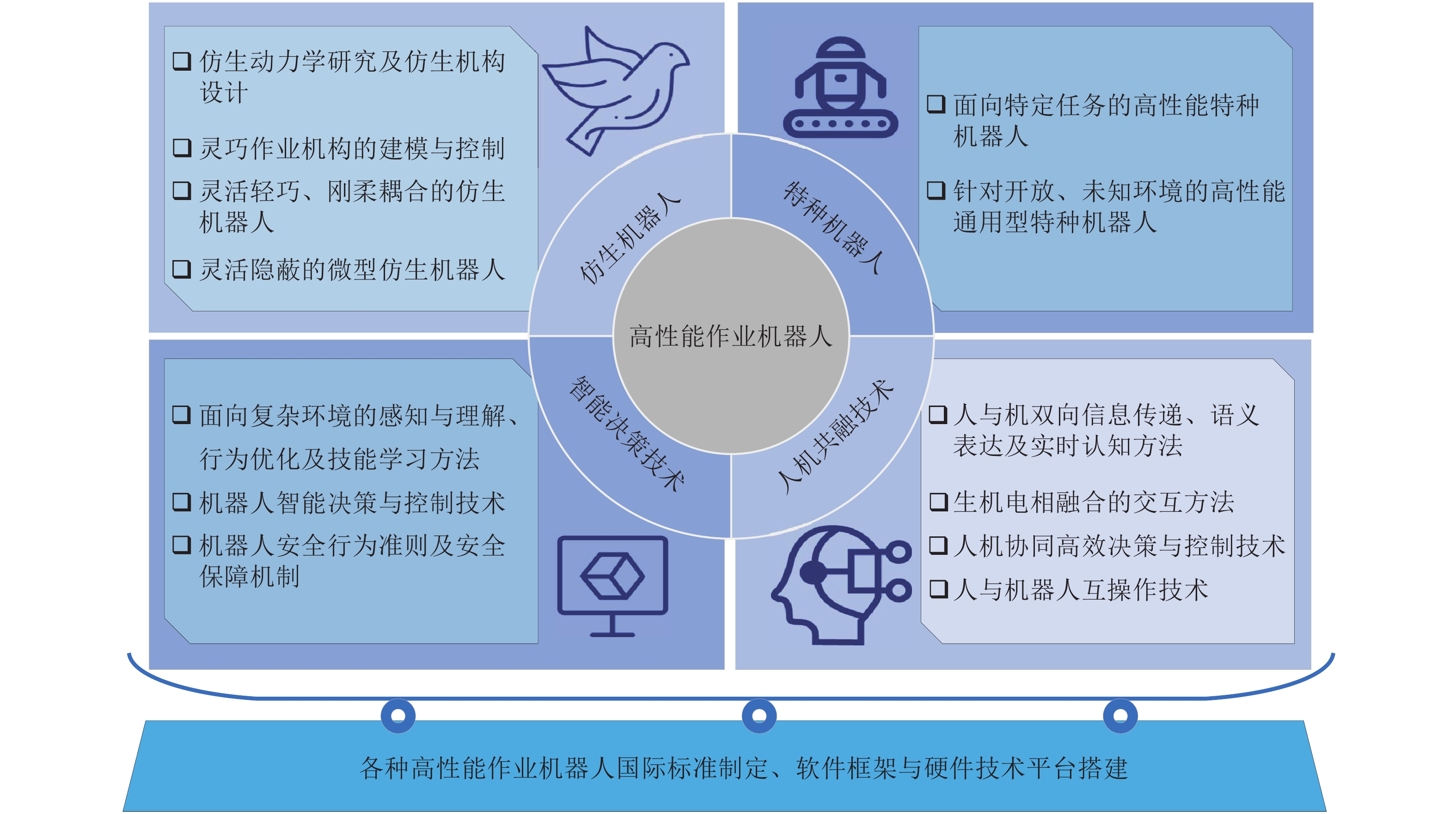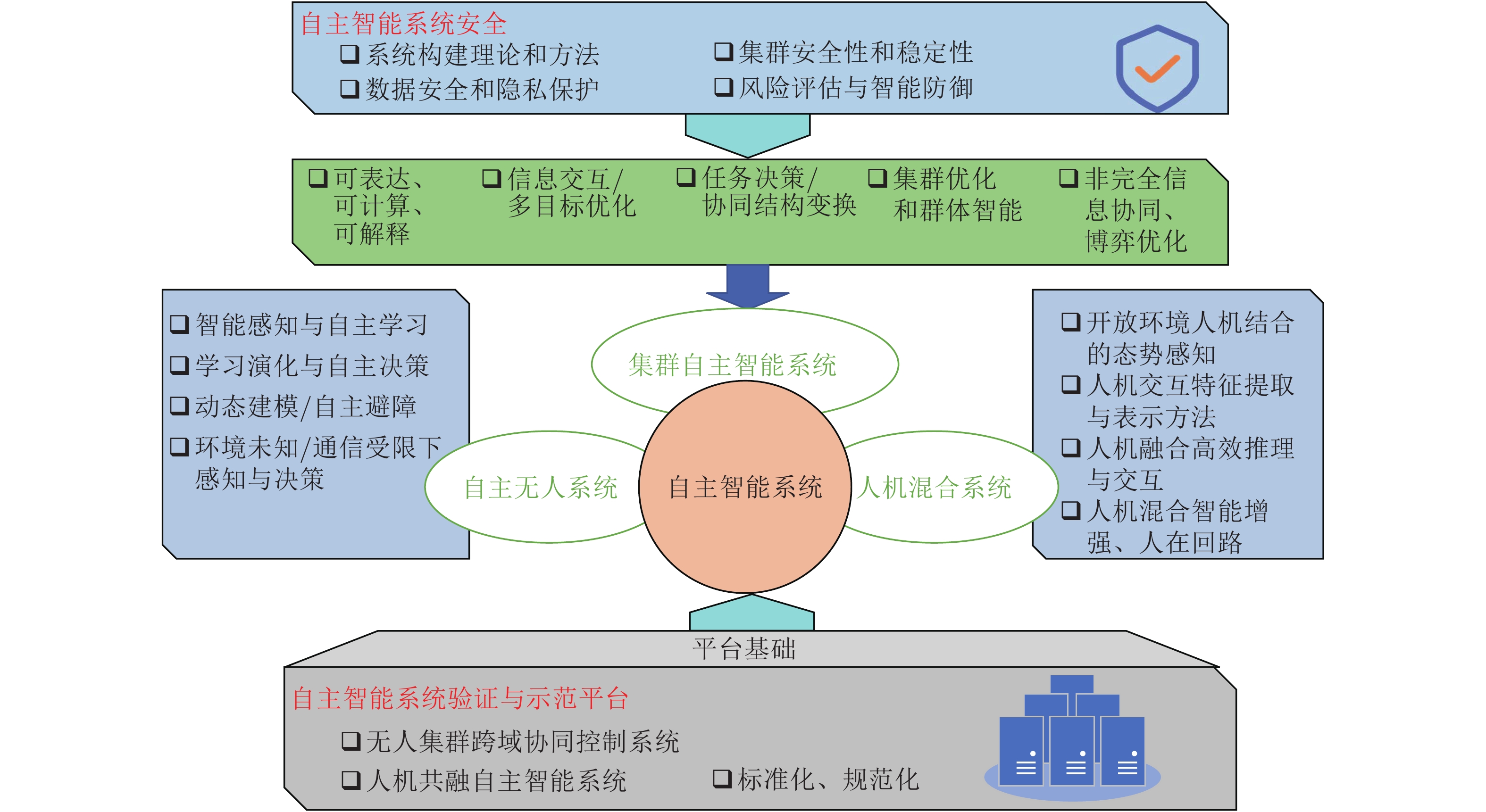-
摘要:
本文分析了控制理论与应用、模式识别与智能系统、导航制导与控制、系统科学与工程、人工智能与自动化交叉等领域的发展现状. 结合科技发展、国内国际研究前沿和新兴领域对自动化科学技术的需求, 提出重点发展智能控制理论和方法、高性能作业机器人、信息物理系统、导航与控制技术、重大装备自动化技术、自主智能系统和人工智能驱动的自动化技术优先领域, 加强数据驱动控制理论、人工智能基础理论研究, 进一步发展人机协同、跨域融合的智能自动化, 为实现国家社会的全面信息化智能化提供理论和技术保障.
Abstract:This paper analyzes the current development of automation science and technology, including fields of control theory and application, pattern recognition and intelligent system, navigation guidance and control, system science and engineering, as well as the interdisciplinary research of artificial intelligence and automation. Combining with the requirements of science and technology development, domestic and international research frontiers, and emerging technologies, the priority areas and specific research directions are put forward to develop intelligent control theory and methodology, high performance robot, cyber-physical system, navigation and control technology, equipment automation technology, autonomous intelligent system and artificial-intelligence-based automation. It is expected to establish the theory framework of data-driven control and artificial-intelligence-based automation. With the intelligent automation of human-machine cooperation and multi-technology integration, it will provide theoretical and technical support for the realization of comprehensive intelligent society.
-
-
[1] 王成红, 宋苏, 刘允刚. 国家自然科学基金与我国控制理论与控制工程学科的发展. 中国基础科学, 2010, 12(6): 38−42 doi: 10.3969/j.issn.1009-2412.2010.06.009Wang Cheng-Hong, Song Su, Liu Yun-Gang. The more and more important effort of scientfic foundation on the subject of control theory and applications. China Basic Science, 2010, 12(6): 38−42 doi: 10.3969/j.issn.1009-2412.2010.06.009 [2] 中国自动化学会. 2016-2017控制科学与工程学科发展报告. 北京: 中国科学技术出版社, 2018China Automation Association. 2016-2017 development report of control science and engineering. Beijing: China Science and Technology Press, 2018 [3] 柴天佑. 自动化科学与技术发展方向. 自动化学报, 2018, 44(11): 1923−1930Chai Tian-You. Development directions of automation science and technology. Acta Automatica Sinica, 2018, 44(11): 1923−1930 [4] 包为民, 祁振强, 张玉. 智能控制技术发展的思考. 中国科学: 信息科学, 2020, 50(08): 1267−1272Bao Wei-Min, Qi Zhen-Qiang, Zhang Yu. Thoughts on the development of intelligent control technology. Scientia Sinica Informationis (in Chinese), 2020, 50(08): 1267−1272 [5] 吴国政. 从F03项目资助情况分析我国自动化学科的发展现状与趋势. 自动化学报, 2019, 45(9): 1611−1619Wu Guo-Zheng. Analysis of the status and trend of the development of China's automation discipline from F03 funding of NSFC. Acta Automatica Sinica, 2019, 45(9): 1611−1619 [6] 邓方, 宋苏, 刘克, 吴国政, 付俊. 国家自然科学基金自动化领域数据分析与研究热点变化. 自动化学报, 2018, 44(2): 377−384Deng Fang, Song Su, Liu Ke, Wu Guo-Zheng, Fu Jun. Data and research hotspot analyses of national natural science foundation of china in automation field. Acta Automatica Sinica, 2018, 44(2): 377−384 [7] Arenas A, Diaz-Guilera A, Kurths J, Moreno Y, Zhou C. Synchronization in complex networks. Physics Reports, 2008, 468(3): 93−153 [8] 钱锋, 杜文莉, 钟伟民, 唐漾. 石油和化工行业智能优化制造若干问题及挑战. 自动化学报, 2017, 43(6): 893−901Qian Feng, Du Wen-Li, Zhong Wei-Min, Tang Yang. Problems and challenges of smart optimization manufacturing in petrochemical industries. Acta Automatica Sinica, 2017, 43(6): 893−901 [9] He W, Li Z, Chen C L P. A survey of human-centered intelligent robots: Issues and challenges. IEEE/CAA Journal of Automatica Sinica, 2017, 4(4): 602−609 [10] Zheng Nan-Ning, Liu Zi-Yi, Ren Peng-Ju, Ma Yong-Qiang, Chen Shi-Tao, Yu Si-Yu, et al. Hybrid-augmented intelligence: Collaboration and cognition. Frontiers of Information Technology & Electronic Engineering, 2017, 18: 153−179 [11] 孙长银, 穆朝絮. 多智能体深度强化学习的若干关键科学问题. 自动化学报, 2020, 46(7): 71−79Sun Chang-Yin, Mu Chao-Xu. Important scientific problems of multi-agent deep reinforcement learning. Acta Automatica Sinica, 2020, 46(7): 71−79 [12] 李晓华. 面向智慧社会的“新基建”及其政策取向. 改革, 2020, 315(5): 34−48Li Xiao-Hua. New infrastructure construction and policy orientation for a smart society. Reform, 2020, 315(5): 34−48 [13] Burdet E, Osu R, Franklin D W, Milner T E, Kawato M. The central nervous system stabilizes unstable dynamics by learning optimal impedance. Nature, 2001, 414(6862): 446−449 [14] Ding Han, Yang Xue-Jun, Zheng Nan-Ning, Li Ming, Lai Yi-Nan, Wu Hao. Tri-Co Robot: A Chinese robotic research initiative for enhanced robot interaction capabilities. National Science Review, 2017, 5(6): 799−801 [15] 中国电子技术标准化研究院. 信息物理系统白皮书 [Online], available: http://www.cesi.cn/201703/2251.html, 2017年1月1日China Electronics Standardization Institute. White paper: Cyber-physical system [Online], available: http://www.cesi.cn/201703/2251.html, January 1, 2017 [16] 王飞跃, 张军, 张俊, 王晓. 工业智联网: 基本概念、关键技术与核心应用. 自动化学报, 2018, 44(9): 1606−1617Wang Fei-Yue, Zhang Jun, Zhang Jun, Wang Xiao. Industrial internet of minds: Concept, technology and application. Acta Automatica Sinica, 2018, 44(9): 1606−1617 [17] 孙长银, 穆朝絮, 张瑞民. 高超声速飞行器终端滑模控制技术. 北京: 科学出版社, 2014Sun Chang-Yin, Mu Chao-Xu, Zhang Rui-Min. Terminal sliding mode control of hypersonic aircrafts. Beijing: Science Press, 2014 [18] 杨浩, 姜斌, 周东华. 互联系统容错控制的研究回顾与展望. 自动化学报, 2017, 43(1): 9−19Yang Hao, Jiang Bin, Zhou Dong-Hua. Review and perspectives on fault tolerant control for interconnected systems. Acta Automatica Sinica, 2017, 43(1): 9−19 [19] 陈杰. 面向社会治理的智能群系统基础研究. 国家自然科学基金委员会第252期双清论坛, 2020Chen Jie. Foundational research on intelligent group system for social governance. The 252nd Shuang-Qing Symposium of National Natural Science Foundation of China, 2020 [20] 吴军, 徐昕, 王健, 贺汉根. 面向多机器人系统的增强学习研究进展综述. 控制与决策, 2011, 26(11): 1601−1610Wu Jun, Xu Xin, Wand Jian, He Han-Gen. Recent advances of reinforcement learning in multi-robot systems: A survey. Control and Decision, 2011, 26(11): 1601−1610 [21] Sutton R S, Barto A G. Reinforcement learning: An introduction. Cambridge MA: MIT Press, 1998 [22] Silver D, Huang A, Maddison C, et al. Mastering the game of Go with deep neural networks and tree search. Nature, 2016, 529(7587): 484−489 -





 下载:
下载:







